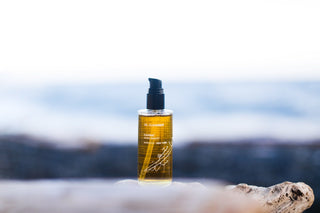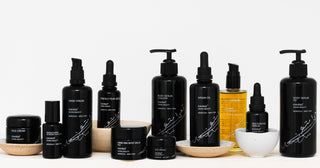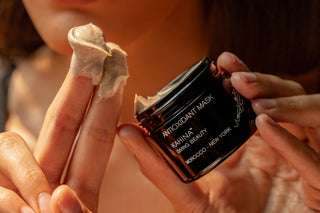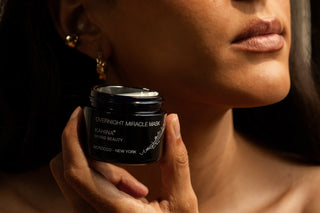 Class is in session! We hope our first lesson on cleansing was helpful. Next up: exfoliation. For skincare addicts, the below information won't likely be anything new, but for skincare freshman, consider this Exfoliation 101.
What is exfoliation?
The removal of surface skin cells.
How do you exfoliate?
Broadly speaking, you have physical exfoliation and you have chemical exfoliation. The former relies on physically buffing away cells, often with an implement, and the latter relies on acids or enzymes to dissolve skin cells.
Who benefits from exfoliation?
Most skin types benefit from some form of exfoliation. Aging, mature or dull skin types can experience an increase in clarity and brightness with regular exfoliation. Acne-prone skin types can benefit from exfoliation when it helps to unclog pores and decrease post-inflammatory hyper-pigmentation. Dry skin types might be hesitant to exfoliate, but it can be a key method of removing dry surface cells and allowing moisturizing products to better penetrate and treat dryness.
Should I manually exfoliate or chemically exfoliate or both or neither?
It depends on your skin type, skin concerns/goals, and how well you tolerate either. We recommend some form of exfoliation for nearly everyone; many people do well with a balance of gentle physical exfoliation with gentle chemical exfoliation. The exception is if your doctor has advised against it or if you have extremely irritation-prone skin that reacts poorly to any kind of exfoliation, even the most gentle methods. In some cases, irritation-prone skin can be healed to the point where gentle exfoliation is possible.
How often should I exfoliate?
Again, this depends on skin type, skin concerns/goals, and how well you tolerate exfoliation. For some, daily physical and chemical - as long as they're gentle - is ideal. For others, it's just once a week. You'll have to experiment a bit to find what works best for you.
How can I tell if I'm overdoing it?
The most common signs of over-exfoliation include redness and increased sensitivity. We recommend you reduce frequency or consider another method if you experience these symptoms. (The exception to this is prescription retinoids; consult your doctor regarding flakiness, redness, or irritation - he or she may adjust your dosage.) It may simply be a question of leaving the exfoliant on for less time, or removing it in a gentler fashion. If you're noticing redness, don't press the face cloth or your fingers too hard into skin but rather lightly swipe product away. If you've over-exfoliated for too long, your skin is compromised and it will take weeks or even months of a very gentle routine to re-establish a functioning moisture barrier that isn't so sensitive.
What are some types of exfoliators?
Aren't infographics fun?
Class is in session! We hope our first lesson on cleansing was helpful. Next up: exfoliation. For skincare addicts, the below information won't likely be anything new, but for skincare freshman, consider this Exfoliation 101.
What is exfoliation?
The removal of surface skin cells.
How do you exfoliate?
Broadly speaking, you have physical exfoliation and you have chemical exfoliation. The former relies on physically buffing away cells, often with an implement, and the latter relies on acids or enzymes to dissolve skin cells.
Who benefits from exfoliation?
Most skin types benefit from some form of exfoliation. Aging, mature or dull skin types can experience an increase in clarity and brightness with regular exfoliation. Acne-prone skin types can benefit from exfoliation when it helps to unclog pores and decrease post-inflammatory hyper-pigmentation. Dry skin types might be hesitant to exfoliate, but it can be a key method of removing dry surface cells and allowing moisturizing products to better penetrate and treat dryness.
Should I manually exfoliate or chemically exfoliate or both or neither?
It depends on your skin type, skin concerns/goals, and how well you tolerate either. We recommend some form of exfoliation for nearly everyone; many people do well with a balance of gentle physical exfoliation with gentle chemical exfoliation. The exception is if your doctor has advised against it or if you have extremely irritation-prone skin that reacts poorly to any kind of exfoliation, even the most gentle methods. In some cases, irritation-prone skin can be healed to the point where gentle exfoliation is possible.
How often should I exfoliate?
Again, this depends on skin type, skin concerns/goals, and how well you tolerate exfoliation. For some, daily physical and chemical - as long as they're gentle - is ideal. For others, it's just once a week. You'll have to experiment a bit to find what works best for you.
How can I tell if I'm overdoing it?
The most common signs of over-exfoliation include redness and increased sensitivity. We recommend you reduce frequency or consider another method if you experience these symptoms. (The exception to this is prescription retinoids; consult your doctor regarding flakiness, redness, or irritation - he or she may adjust your dosage.) It may simply be a question of leaving the exfoliant on for less time, or removing it in a gentler fashion. If you're noticing redness, don't press the face cloth or your fingers too hard into skin but rather lightly swipe product away. If you've over-exfoliated for too long, your skin is compromised and it will take weeks or even months of a very gentle routine to re-establish a functioning moisture barrier that isn't so sensitive.
What are some types of exfoliators?
Aren't infographics fun?

 These obviously aren't exhaustive lists - there are just too many! But the below charts list some common ones. In the chemical category, we tried to choose naturally derived options, with the exception of retinoids, which are so popular we couldn't not include them.
These obviously aren't exhaustive lists - there are just too many! But the below charts list some common ones. In the chemical category, we tried to choose naturally derived options, with the exception of retinoids, which are so popular we couldn't not include them.
AHAs: alpha hydroxy acids include glycolic, malic, lactic, and mandelic acids. Can be helpful in lightening hyper-pigmentation, evening skin tone, improving the look of fine lines and wrinkles, and addressing some acne. BHAs: beta hydroxy acids like salicylic acid. Better penetrate the pore to dissolve keratinized skin within. Helpful in addressing some acne. Retinoids: products derived from vitamin A. Help regulate cell turnover and reduce the clogging of pores due to uneven shedding of skin cells. Some are over-the-counter and gentler, as the skin has more work to do to synthesize the exfoliator. Prescription forms include tretinoin (Retin-A), isotretinoin (Accutane), and adalpene (Differin).
How do Kahina Giving Beauty products help me exfoliate? You'll find the physical exfoliant rhassoul clay in Kahina Antioxidant Mask. Rhassoul clay is finely ground, then combined with argan oil and other emollient and antioxidant ingredients to create a creamy mask. You will not need to add any ingredients like some dry clay masks. Rhassoul is a rather gentle clay and can be used on all skin types, especially in this preparation which is moisturizing. More sensitive skin types can leave mask on for 5 minutes and then remove gently in long strokes, whereas most skin types can leave on for 10-15 minutes then gently buff the fine grains into skin to complete the exfoliation process. The enzymatic exfoliant papain is found in Kahina Facial Cleanser. Papain sloughs off cells and softens skin. It's the perfect way to incorporate super gentle exfoliation into your daily routine. For those seeking more exfoliation, pair our Facial Cleanser with a konjac sponge or muslin, or even a facial brush/Clarisonic. Most skin types will do well with the following exfoliation routine: AM & PM, daily: Kahina Facial Cleanser (with or without muslin, face cloth, konjac sponge, or facial brush, as desired) Weekly: Kahina Antioxidant Mask Any other recommendations? For those seeking all-natural chemical exfoliation in addition to what Kahina has to offer, we recommend daily or every-other-day topical applications of Apple Cider Vinegar (diluted with distilled water) or weekly greek yogurt masks. These food items are readily available at your grocery store and well-tolerated by most. We find it's a simple way to begin experimenting with exfoliation and how it can help your skin. For the greek yogurt mask, spread a medium layer on and allow to sit for up to 30 minutes. If you feel any burning before then, remove with water. As for physical exfoliation, the simplest place to start is with the washcloth you (most likely) already own. What about body exfoliation? Exfoliation is key for your body, too. Body exfoliators tend to be physical - a mitt or glove or scrubs with ground particles. We'll be introducing a traditional Moroccan method of exfoliation for body in the very near future - stay tuned!



